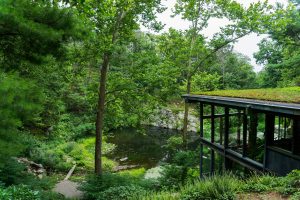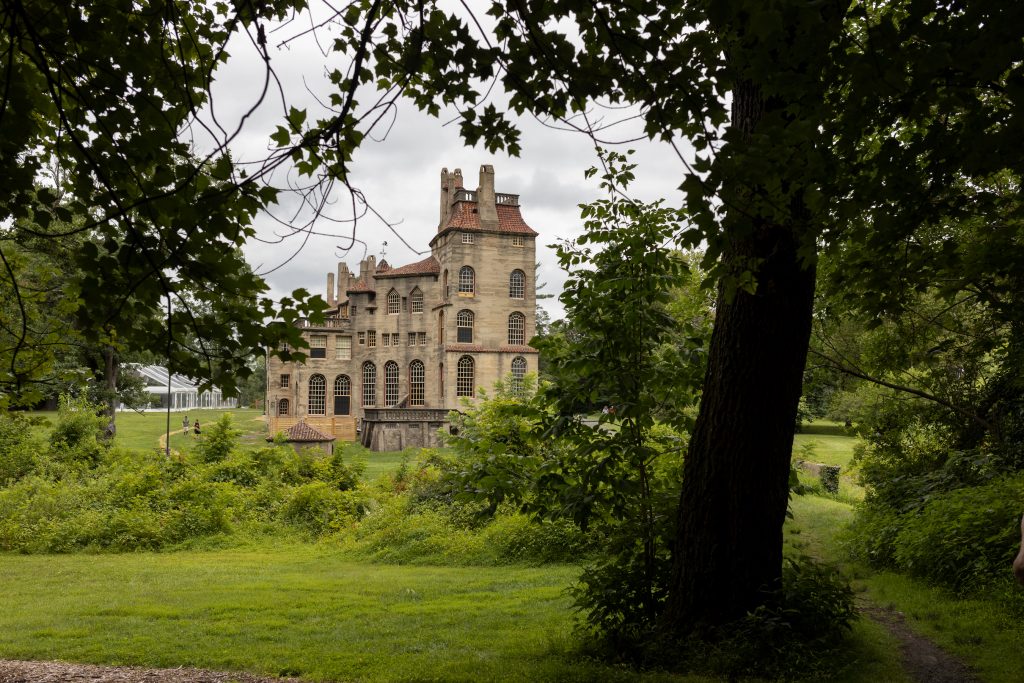On a recent trip to the East Coast, I made a point of visiting the former homes and studios of three late artists.
The Moravian Pottery & Tile Works in Doylestown, Pennsylvania, was the studio of historian Henry Chapman Mercer (1856-1930), a self-taught architect, ceramicist, and collector.
He modeled the design for his tile works on the California missions he’d seen on his travels. Then he added his own stamp, which might be called “Early Hobbit.”
The compound is now a nonprofit history museum, offering guided tours to the public, as well as an annual Tile Fest, summer music and movie series, visiting artist residencies and workshops.
It’s also a humming working studio, producing among other items mosaic murals, floors, patios, fireplace surrounds, hearths, and architectural friezes. The tiles, available for purchase in the museum store, are still pressed from the over 6,000 molds designed by Mercer.
The next day I moved on to his former residence: the adjacent Fonthill Castle. With 44 rooms, 32 staircases, 21 chimneys, 10 bathrooms, and 200 windows, in 1908-1912, the castle (actually a large poured-in-concrete house) cost $32,000 to build.
There were dumbwaiters, elevators, call bells, and a central heating system.
The biggest room, a kind of one-off grand hall, was interrupted every few feet by a floor-to-ceiling, tile-embedded concrete column (turned out Mercer erred on the side of caution and had the edifice constructed five times stronger than it needed to be).
In fact every square inch of the castle, almost, was plastered with tile: the floors, the walls, the window and fireplace surrounds.
Mercer loved to tell stories, and the subjects of his molds range from mythology to Holy Grail quests to parables from the Bible. The ceiling of one of his favorite rooms was covered with tiles that told the story of Columbus’s conquest of the New World. Other subjects included animals, family crests, fairy tale figures, sheaves of wheat, fruit.
Even on a sunny day the castle was gloomy and chill. Maybe I’ve been too long out west — but I couldn’t imagine spending a whole winter there.
Next stop was the museum/studio/former home of Wharton Esherick (1887-1970), an artist, sculptor, and furniture designer who lived in the hills above the Pennsylvania town of Paoli.
Esherick made a lot of furniture in particular that was lovely — lamps, desks, tables, chairs — out of wood. His hand-hewn and eccentrically unique living space was filled with carvings, sculptures, paintings, gorgeous chairs, custom-made sofas, a fireplace, hand-made serving utensils, desks with built in lamps, sliding trays for drawings and prints, inlaid work-of-art floors made from scrap wood.
The house, as was true of Fonthill, was also insanely impractical, with narrow winding l staircases, very little open space in which to move, and with hardly any natural light.
A couple of days later, I drove to upstate New York and visited Manitoga, aka Dragon Rock, the former home of Russel Wright (1904-1976). Best known as a mid-century designer of clean-lined dish collections in sophisticated shades of chartreuse, teal, and slate gray, in 1942 Wright bought 75 acres of a former logging site and abandoned quarry.
The Japanese-inspired indoor-outdoor design featured views of the Wright-designed waterfall, quarry pool and woodland garden. Here, too, inside and out, were the irregular, winding granite steps which, if I hadn’t sprained my knee the week before in a fall on a New York City sidewalk, might have struck me as slightly more picturesque.

Here, too, the creativity and natural beauty were stunning — and faintly underlain by damp, chill, moss, and mold.
Don’t get me wrong. All three homes were wondrous. I wouldn’t have missed them for the world. Still, I couldn’t help reflecting afterwards that the effort to preserve in amber any human life carries a touch of the absurd.
Does a meticulous catalogue really need to be maintained of Henry Chapman Mercer’s thousands of decomposing library books?
What purpose is served by keeping Esherick’s L.L. Bean shirts still folded in a drawer beneath his bed, and on a shelf in the kitchen the spices, in their little metal cans, that he used 50 years before?
A house that’s not lived in begins to disintegrate in some way, is sapped of its vitality, begins to waft the air of a moldering tomb.
The Catholic tradition of venerating relics, a matter of high hilarity among non-believers, is actually a glimpse into the realm of eternal life.
In Rome, for example, you can visit the rooms where the mendicant St. Benedict Joseph Labré (1748-1783) lived for two years before his death.
But you don’t kneel in mere rooms. For that, gaze upon the secondary relics preserved in the nearby house chapel of San Benedetto Giuseppe Labre ai Monti: the filthy rags the saint was wearing when he died.

